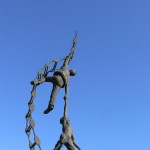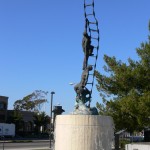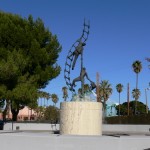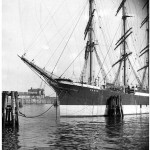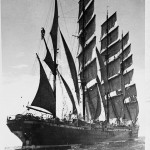Archive for July, 2010
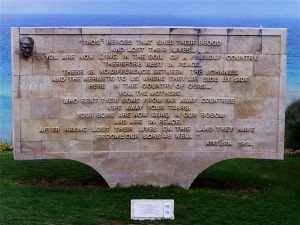 In the inglorious and brutal history of warfare, few places have ever witnessed the carnage that played out in World War I at a place in Turkey called Gallipoli. From April 25, 1915 to January 9, 1916 a joint British and French operation was conducted to capture the Ottoman Empire capital of Istanbul and to control the Dardanelles – the sea route to Russia. The British and French operation failed, but only after the deaths of over 130,000 participants – with an additional 261,000 wounded. Many experts estimate that the dead and wounded total is actually significantly higher.
In the inglorious and brutal history of warfare, few places have ever witnessed the carnage that played out in World War I at a place in Turkey called Gallipoli. From April 25, 1915 to January 9, 1916 a joint British and French operation was conducted to capture the Ottoman Empire capital of Istanbul and to control the Dardanelles – the sea route to Russia. The British and French operation failed, but only after the deaths of over 130,000 participants – with an additional 261,000 wounded. Many experts estimate that the dead and wounded total is actually significantly higher.
The casualties came from seemingly everywhere – the United Kingdom, Turkey, France, Australia, New Zealand, British India, Newfoundland, Germany, Austria, Hungary, and French West Africa. Gallipoli was an equal opportunity place of courage, sacrifice, devotion to duty, and death. Almost half of the dead were never identified – body parts by the thousands buried in mass graves. Hundreds more died in naval actions supporting the landings, forever lost to the sea off the coast of Turkey
Cemeteries and monuments are found throughout the area. They are somber and beautiful and meticulously maintained by several countries. One of the heroes on the Turkish side was Mustafa Kemal. His rise to the presidency of Turkey began at Gallipoli – a place he would always hold sacred for anyone, regardless of country, who fought at that horrific time and place. In 1934 Kemal, now known as Ataturk, was President of Turkey. He ordered the construction of a monument at ANZAC Cove. ANZAC was the Australian-New Zealand Army Corp. ANZAC Cove was the location of one of the landings made by Australian and New Zealand Army troops during the campaign. ANZAC Cove was a place of particular killing and sorrow.
Expand the photograh and read the words of Ataturk. Seven decades have not decreased their power or eloquence – nor will seven centuries.
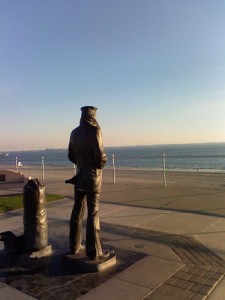 One of the most iconic sculptures found in the United States is The Lone Sailor, a tribute to those of all the sea services. The sculpture was originally created by Stanley Bleifeld for the United States Navy Memorial in Washington, D.C. It was first erected there in 1987. There are at least eleven other other copies located around the United States.
One of the most iconic sculptures found in the United States is The Lone Sailor, a tribute to those of all the sea services. The sculpture was originally created by Stanley Bleifeld for the United States Navy Memorial in Washington, D.C. It was first erected there in 1987. There are at least eleven other other copies located around the United States.
While not a lost at sea memorial per se, it most certainly represents a scene witnessed tens of thousands of times around the world – a mariner silently waiting for his ship. In all too many cases this scene would be the mariner’s last time spent on solid ground, as he would eventually become another soul lost at sea.
The design of statue always reminds me of the opening scene in the movie “The Sand Pebbles”, as Jake Holman mutters “Hello ship” to his new vessel the San Pablo.
The beautiful photograph in this post was taken by Manuel Ortiz (Mortis24 on Panoramio). It is of the sculpture found in Long Beach, California. I love the perspective in Manuel’s photograph – the sailor looking out to sea, where an unknown fate awaits…
“Jacob’s Ladder” is often used as a biblical allusion from Genesis to Jacob’s dream of a ladder reaching to heaven. For those who have served at sea it is also a term for a rope or cable ladder, with wooden steps, that hangs off the side of a ship. Jacob’s Ladders sway, twist and slap the sides of a ship with the wind and the waves. They are not a favorite piece of equipment for any sailor, but for a sailor in peril a Jacob’s Ladder can often be the only route to survival.
The main focus of the American Merchant Marine Veterans’ Memorial in San Pedro, California is the unforgettable work of art by the late sculptor Jasper D’Ambrosi of one shipmate attempting to save another while clinging by a single hand to a Jacob’s Ladder. The concept and the design of the memorial are superb – capturing courage, strength, fear and hope in a single image. It is a moment that is universal, experienced by sailors of every nation for as long as humans have sailed the oceans. It may have happened because of a battle or a storm or an accident. It is that single moment that is the dividing point between success and failure, between life and death. It is a moment that I have personally witnessed. The D’Ambrosi work is among my favorite lost at sea memorials.
The beautiful photographs in this post were taken by Alfonso Pauwells (saxxon57 on Panoramio). I encourage everyone to seek out and view his fine photographs.
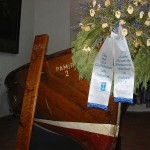 In a corner of St. Jacob’s Church (known as the seafarers church) in Lubeck, Germany is a memorial to the windjammer Pamir. The memorial is simple – a salvaged lifeboat from the stricken ship and a board listing the names of the 80 souls who were lost at sea in September 1957 off the Azones.
In a corner of St. Jacob’s Church (known as the seafarers church) in Lubeck, Germany is a memorial to the windjammer Pamir. The memorial is simple – a salvaged lifeboat from the stricken ship and a board listing the names of the 80 souls who were lost at sea in September 1957 off the Azones.
This website is devoted to memorials to those lost at sea, but sometimes it is difficult to ignore the history of some of the proud and beautiful ships that also rest at the bottom of the world’s oceans.
The Pamir was one of the last great windjammers. The four-masted barque was built in Hamburg and launched in July 1905. She was the fifth of ten near sister ships – with a length of 375 feet, a beam of 46 feet, with three main masts that stood 168 feet above her deck. She was capable of deploying over 40,000 square feet of sail area. She carried grain and nitrates to and from Europe, Asia and South America until WWII. In August 1941 she was serving under the flag of Finland.
During WWII she was seized as a war prize by New Zealand, continuing to haul freight during the entire conflict. She made numerous trips from New Zealand to San Francisco, Vancouver and Sydney. In 1948 she was returned to the Erikson Line of Finland, where she resumed hauling Australian grain to Europe. In 1949 she hauled barley from Australia to England, becoming the last windjammer to carry a commercial load around Cape Horn. In the early 1950s she was sold to a German consortium. where she was used as a cargo-carrying school ship on a route primarily between Germany and Argentina.
On August 10, 1957 the Pamir left Buenos Aires for Hamburg with a crew of 86, including 52 merchant marine cadets. On September 21, 1957 she was caught in Hurricane Carrie before shortening sails. She was apparently unaware of the hurricane, being caught with open hatchways. Considerable water entered the ship, the grain cargo shifted and the ship listed severely to port. Her port side eventually went underwater, leading to her loss.
The ship was able to send three distress signals before sinking. A nine-day search for survivors was organized by the United States Coast Guard, but only four crew members and two cadets were ever found. The rest of the crew perished 600 miles west-southwest of the Azores. None of the ship’s officers survived, so there was never any testimony as to how the ship was caught so unprepared for the hurricane.
The memorial in St. Jacob’s Church displays one of the two lifeboats that were eventually found.
Two ships very similar to Pamir can still be seen – the Peking at the South Street Seaport in New York City and the Passat in Travemunde, Germany. Several fine books can also be found that describe the history and final voyage of Pamir:
The Last Time Around Cape Horn by William Stark
The Pamir under the New Zealand Ensign by Jack Churchouse
Tall Ships Down by Daniel Parrott
 A second memorial on Cape Horn can be found within walking distance of the Albatross Memorial featured in a previous post. This memorial, like the Albatross, pays tribute to those who have lost their lives in the transit of Cape Horn – but it also pays tribute to those who successfully made the journey in the three-hundred years of commercial sail and exploration in the great windjammers.
A second memorial on Cape Horn can be found within walking distance of the Albatross Memorial featured in a previous post. This memorial, like the Albatross, pays tribute to those who have lost their lives in the transit of Cape Horn – but it also pays tribute to those who successfully made the journey in the three-hundred years of commercial sail and exploration in the great windjammers.
Translated, the monument reads:
“To those who have crossed it and to those who have lost their lives to its demands.”
